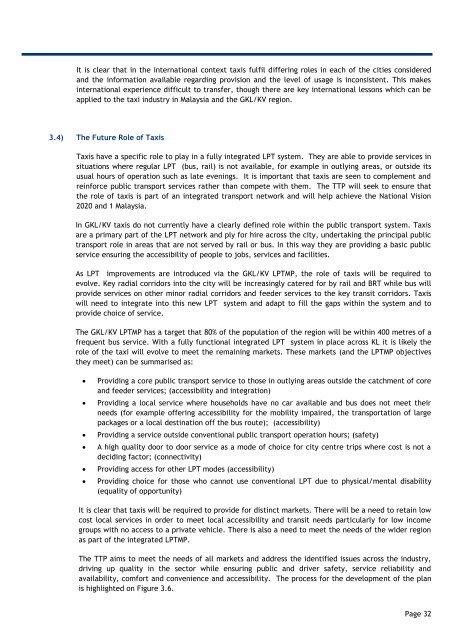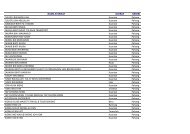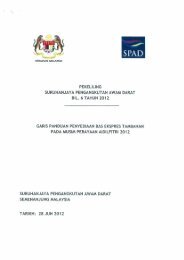4. Developing the Taxi Transformation Plan - SPAD
4. Developing the Taxi Transformation Plan - SPAD
4. Developing the Taxi Transformation Plan - SPAD
You also want an ePaper? Increase the reach of your titles
YUMPU automatically turns print PDFs into web optimized ePapers that Google loves.
It is clear that in <strong>the</strong> international context taxis fulfil differing roles in each of <strong>the</strong> cities considered<br />
and <strong>the</strong> information available regarding provision and <strong>the</strong> level of usage is inconsistent. This makes<br />
international experience difficult to transfer, though <strong>the</strong>re are key international lessons which can be<br />
applied to <strong>the</strong> taxi industry in Malaysia and <strong>the</strong> GKL/KV region.<br />
3.4) The Future Role of <strong>Taxi</strong>s<br />
<strong>Taxi</strong>s have a specific role to play in a fully integrated LPT system. They are able to provide services in<br />
situations where regular LPT (bus, rail) is not available, for example in outlying areas, or outside its<br />
usual hours of operation such as late evenings. It is important that taxis are seen to complement and<br />
reinforce public transport services ra<strong>the</strong>r than compete with <strong>the</strong>m. The TTP will seek to ensure that<br />
<strong>the</strong> role of taxis is part of an integrated transport network and will help achieve <strong>the</strong> National Vision<br />
2020 and 1 Malaysia.<br />
In GKL/KV taxis do not currently have a clearly defined role within <strong>the</strong> public transport system. <strong>Taxi</strong>s<br />
are a primary part of <strong>the</strong> LPT network and ply for hire across <strong>the</strong> city, undertaking <strong>the</strong> principal public<br />
transport role in areas that are not served by rail or bus. In this way <strong>the</strong>y are providing a basic public<br />
service ensuring <strong>the</strong> accessibility of people to jobs, services and facilities.<br />
As LPT improvements are introduced via <strong>the</strong> GKL/KV LPTMP, <strong>the</strong> role of taxis will be required to<br />
evolve. Key radial corridors into <strong>the</strong> city will be increasingly catered for by rail and BRT while bus will<br />
provide services on o<strong>the</strong>r minor radial corridors and feeder services to <strong>the</strong> key transit corridors. <strong>Taxi</strong>s<br />
will need to integrate into this new LPT system and adapt to fill <strong>the</strong> gaps within <strong>the</strong> system and to<br />
provide choice of service.<br />
The GKL/KV LPTMP has a target that 80% of <strong>the</strong> population of <strong>the</strong> region will be within 400 metres of a<br />
frequent bus service. With a fully functional integrated LPT system in place across KL it is likely <strong>the</strong><br />
role of <strong>the</strong> taxi will evolve to meet <strong>the</strong> remaining markets. These markets (and <strong>the</strong> LPTMP objectives<br />
<strong>the</strong>y meet) can be summarised as:<br />
<br />
<br />
<br />
<br />
<br />
<br />
Providing a core public transport service to those in outlying areas outside <strong>the</strong> catchment of core<br />
and feeder services; (accessibility and integration)<br />
Providing a local service where households have no car available and bus does not meet <strong>the</strong>ir<br />
needs (for example offering accessibility for <strong>the</strong> mobility impaired, <strong>the</strong> transportation of large<br />
packages or a local destination off <strong>the</strong> bus route); (accessibility)<br />
Providing a service outside conventional public transport operation hours; (safety)<br />
A high quality door to door service as a mode of choice for city centre trips where cost is not a<br />
deciding factor; (connectivity)<br />
Providing access for o<strong>the</strong>r LPT modes (accessibility)<br />
Providing choice for those who cannot use conventional LPT due to physical/mental disability<br />
(equality of opportunity)<br />
It is clear that taxis will be required to provide for distinct markets. There will be a need to retain low<br />
cost local services in order to meet local accessibility and transit needs particularly for low income<br />
groups with no access to a private vehicle. There is also a need to meet <strong>the</strong> needs of <strong>the</strong> wider region<br />
as part of <strong>the</strong> integrated LPTMP.<br />
The TTP aims to meet <strong>the</strong> needs of all markets and address <strong>the</strong> identified issues across <strong>the</strong> industry,<br />
driving up quality in <strong>the</strong> sector while ensuring public and driver safety, service reliability and<br />
availability, comfort and convenience and accessibility. The process for <strong>the</strong> development of <strong>the</strong> plan<br />
is highlighted on Figure 3.6.<br />
Page 32

















